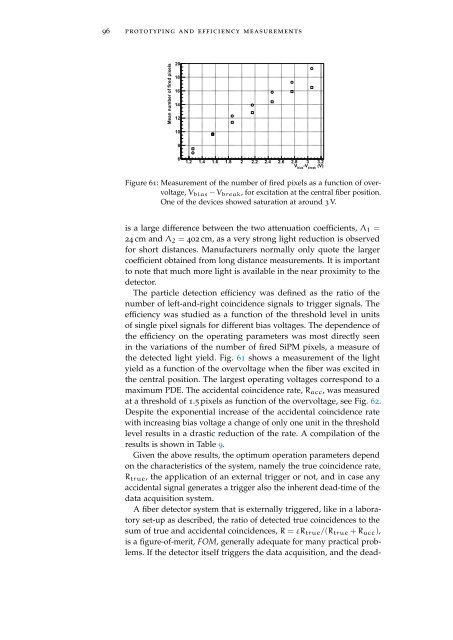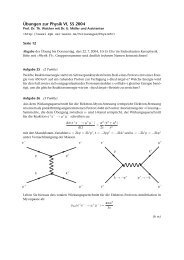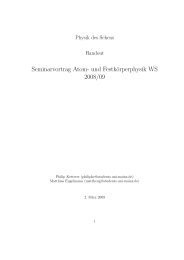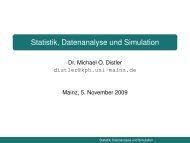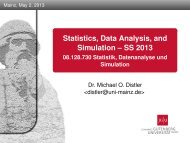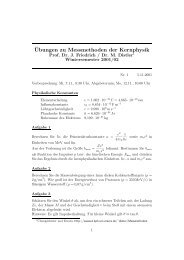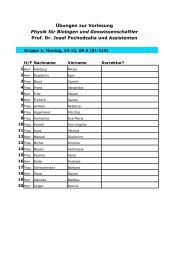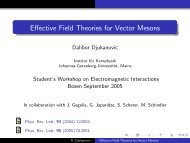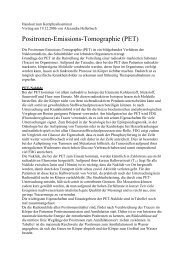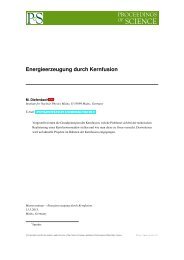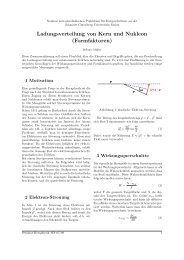A Classic Thesis Style - Johannes Gutenberg-Universität Mainz
A Classic Thesis Style - Johannes Gutenberg-Universität Mainz
A Classic Thesis Style - Johannes Gutenberg-Universität Mainz
You also want an ePaper? Increase the reach of your titles
YUMPU automatically turns print PDFs into web optimized ePapers that Google loves.
96 prototyping and efficiency measurements<br />
Mean number of fired pixels<br />
20<br />
18<br />
16<br />
14<br />
12<br />
10<br />
8<br />
6<br />
1.2 1.4 1.6 1.8 2 2.2 2.4 2.6 2.8 3 3.2<br />
V -V<br />
bias<br />
(V)<br />
break<br />
Figure 61: Measurement of the number of fired pixels as a function of overvoltage,<br />
Vbias − Vbreak, for excitation at the central fiber position.<br />
One of the devices showed saturation at around 3 V.<br />
is a large difference between the two attenuation coefficients, Λ1 =<br />
24 cm and Λ2 = 402 cm, as a very strong light reduction is observed<br />
for short distances. Manufacturers normally only quote the larger<br />
coefficient obtained from long distance measurements. It is important<br />
to note that much more light is available in the near proximity to the<br />
detector.<br />
The particle detection efficiency was defined as the ratio of the<br />
number of left-and-right coincidence signals to trigger signals. The<br />
efficiency was studied as a function of the threshold level in units<br />
of single pixel signals for different bias voltages. The dependence of<br />
the efficiency on the operating parameters was most directly seen<br />
in the variations of the number of fired SiPM pixels, a measure of<br />
the detected light yield. Fig. 61 shows a measurement of the light<br />
yield as a function of the overvoltage when the fiber was excited in<br />
the central position. The largest operating voltages correspond to a<br />
maximum PDE. The accidental coincidence rate, Racc, was measured<br />
at a threshold of 1.5 pixels as function of the overvoltage, see Fig. 62.<br />
Despite the exponential increase of the accidental coincidence rate<br />
with increasing bias voltage a change of only one unit in the threshold<br />
level results in a drastic reduction of the rate. A compilation of the<br />
results is shown in Table 9.<br />
Given the above results, the optimum operation parameters depend<br />
on the characteristics of the system, namely the true coincidence rate,<br />
Rtrue, the application of an external trigger or not, and in case any<br />
accidental signal generates a trigger also the inherent dead-time of the<br />
data acquisition system.<br />
A fiber detector system that is externally triggered, like in a laboratory<br />
set-up as described, the ratio of detected true coincidences to the<br />
sum of true and accidental coincidences, R = εRtrue/(Rtrue + Racc),<br />
is a figure-of-merit, FOM, generally adequate for many practical problems.<br />
If the detector itself triggers the data acquisition, and the dead-


